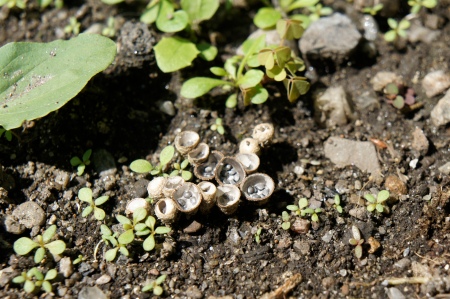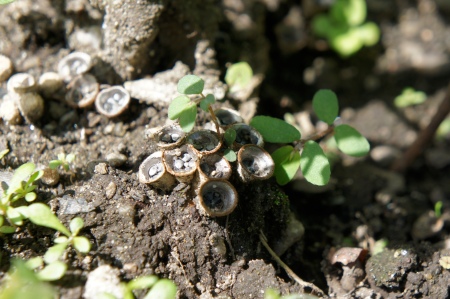So I found these when I was out weeding the garden one afternoon:
A clump of mini bird nests! Small cups, about the size of a dime, with bunches of tiny, grey, shiny “eggs” inside. Something in the back of my brain stirred. A distant memory of a clip from a nature video: a rain drop falling in slow motion, hitting a cup and jettisoning the small, grey, flattened spheres inside.
A Google search later and my memory is confirmed. Birds nest fungi, members of the family, Nidulariaceae. They are saprophytes, meaning they grow and live off of dead wood, decaying organic matter, manure, and mulch. Hence they prefer damp shady environments. The chalice shaped mushrooms come in a variety of colors, white, grey, brown… The egg-like shapes inside are called peridoles, which are usually grey or black, but can be white. While young and growing, the clusters of fungi resemble puffballs, which eventually blossom open to reveal the nest inside when they have matured.
The cup/egg situation provides a unique way for dispersing the egg spores. My nature video memory is no fallacy! When a rain drop falls on the cup, the eggs are flung upwards to a meter, and stick to where ever they land. Once the egg dries out, it splits open, and releasing fungal spores.
My neighbor’s first thought was: ugh, I hope they don’t impact our tomato production! But, good news, they’re harmless! Think about it, they feed on dead plant matter. So your plants can live safe, as long as they’re living. But, not surprisingly, some folks will call these cuties, hideous and creepy, and will want to know how to remove it from their pristine, desolate, property. Simple raking over them and avoiding adding moisture to the area will help, fungicides are not recommended. Because they pop up among mulch, it could be wise to switch non organic mulch, such as rocks. I also found complaints online about the periodoles sticking to the side of the house, patio furniture, or car. And apparently, this is a bad thing?
Of course, you have to appreciate this:
Sources:
http://hort.uwex.edu/articles/bird%E2%80%99s-nest-fungi
http://www.extension.umn.edu/garden/yard-garden/diseases/birds-nest-fungi/
http://mdc.mo.gov/discover-nature/field-guide/splash-cup-bird-s-nest-fungus
http://www.uaex.edu/publications/pdf/FSA-7573.pdf

